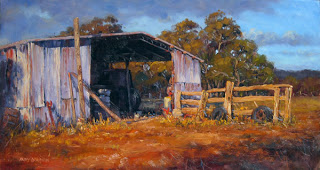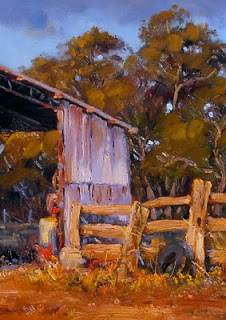On the recent sketching picnic with the Porongurup Art Group I managed to snap a few photos of a farm shed during a short period when some evening sunlight broke through the heavy clouds. It’s taken me a while to get around to turning the photos into a painting but finally, here it is – step-by-step.
More often than not I work from sketches from the computer screen. I load up the digital photo, make some minor adjustments so that it matches my memory of the light and colour of the day, crop roughly to the proportions I want for the finished painting and then do a small pencil sketch. I add colour notes to the sketch, often with reference to my trusty colour charts, and I use this sketch as my main reference for the painting process.
Working this way has some of the advantages of working on site since I am forced to simplify the image into a tonal sketch and then to simplify major colour areas, taking note of warm and cool passages. The time spent doing this helps to cement the image in my mind too so that some of what ends up in the painting comes from my own memory. Only when I’m nearing the end of the painting will I refer back to the colour photo to look for some final details, if I feel they’ll add useful finishing touches.
 I usually lay my composition out freehand with thin paint. In this case the shape of the shed was critical – if the perspective was off just a little, the painting would fail – so I gridded up a black and white print of the photo and transferred it to the board in pencil. This meant I could concentrate on getting the paint down, without worrying about whether a roof line was two degrees out.
I usually lay my composition out freehand with thin paint. In this case the shape of the shed was critical – if the perspective was off just a little, the painting would fail – so I gridded up a black and white print of the photo and transferred it to the board in pencil. This meant I could concentrate on getting the paint down, without worrying about whether a roof line was two degrees out.
Because this was to be a warm painting, I underpainted major areas with a burnt sienna wash. At this stage I wanted to break the surface into just a few major tonal areas. The washes were thin enough that I could just make out some of the pencil work for later.
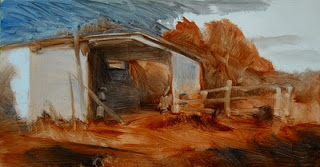 I broke up the major tones with the addition of some darker passages by adding a little French ultramarine to the mix. The cloud mass was ultramarine with a little burnt sienna added to grey it off. I used a brush moistened with turps to remove some underpainting from the post-and-rail fence
I broke up the major tones with the addition of some darker passages by adding a little French ultramarine to the mix. The cloud mass was ultramarine with a little burnt sienna added to grey it off. I used a brush moistened with turps to remove some underpainting from the post-and-rail fence
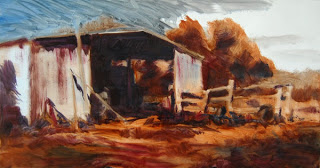 The interior of the shed was very dark due to the strong sunlight on the outside walls. I’ve used French ultramarine, burnt sienna and permanent crimson to roughly block in the dark silhouette. I’ve strengthened the large trees behind the shed as the sunlit fence will need to contrast against these. A little burnt sienna has been dragged over the corrugated sheets on the shed front in order to give this area a little modelling and to break down the large light area.
The interior of the shed was very dark due to the strong sunlight on the outside walls. I’ve used French ultramarine, burnt sienna and permanent crimson to roughly block in the dark silhouette. I’ve strengthened the large trees behind the shed as the sunlit fence will need to contrast against these. A little burnt sienna has been dragged over the corrugated sheets on the shed front in order to give this area a little modelling and to break down the large light area.
Some minor details are hinted at with rough areas of tone. If you blur your eyes at this stage you should see if things are working out.
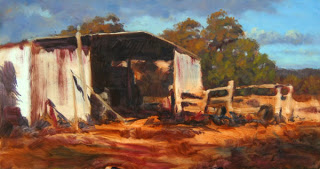 To take the painting toward completion, I begin in the sky. The clear sky area is mostly cerulean blue and white. A little ultramarine is added toward the top. The clouds are primarily ultramarine and crimson with some cerulean and yellow ochre worked liberally into them to reduce the flatness. Sunlight on the distant clouds is made with yellow ochre and cadmium yellow deep into white.
To take the painting toward completion, I begin in the sky. The clear sky area is mostly cerulean blue and white. A little ultramarine is added toward the top. The clouds are primarily ultramarine and crimson with some cerulean and yellow ochre worked liberally into them to reduce the flatness. Sunlight on the distant clouds is made with yellow ochre and cadmium yellow deep into white.
Next I work on the sunlit trees. Combinations of yellow ochre, cerulean blue, permanent crimson and cadmium yellow (deep and light) add variety to the masses. I still have to add colour to the trees seen though the shed. The bottoms of these trees are in the shed’s shadow.
Shrubs in the distance are added with little fuss.
 The distant paddock is added with a few simple brushtrokes and subtle colour shifts, no need for detail back here. I’ve used yellow ochre and cadmium yellow light over burnt sienna. Sunlit trunks are added to the trees and a few fence posts are loosely indicated in the distance.
The distant paddock is added with a few simple brushtrokes and subtle colour shifts, no need for detail back here. I’ve used yellow ochre and cadmium yellow light over burnt sienna. Sunlit trunks are added to the trees and a few fence posts are loosely indicated in the distance.
I’ve also added colour to the shed walls. The bright area on the sunlit side is cadium yellow deep in white. The sunlit rust areas are cadium scarlet and burnt sienna while the shadowed rust is burnt sienna with a little ultramarine added. The front walls are more side-on to the sunlight so they aren’t as bright overall. I subdued the sunlit wall colour with a little ultramarine.
The blue-purple shadow area under the roof on the near wall helps this area to come alive while the shadow of a tree on the sunlit wall stops this otherwise bright area from dominating and taking the eye out of the painting.
I’ve added some warm tones to the fence, combinations of cadmium yellow deep and cadmium scarlet into white, applied over a burnt sienna base. A few bright flashes of pure colour have been “thrown around”. These will add minor visual interest later. I’ve also worked a little more on the interior of the shed, adding subtle shifts in tone to give a hint of the objects in there.
The painting is finished with the foreground completed, some extra “sky holes” in the trees and final touches added to the shed walls.
My main interest in this work was the warmth of the summer-evening light on an otherwise overcast day. The dark shadow inside the shed invites the curious while the sunlit post-and-rail fence leads the way and helps balance the massive bulk of the shed that would otherwise weigh-down the left side of the painting. The paraphernalia lying around and leaning against walls and fences tells its own story.


